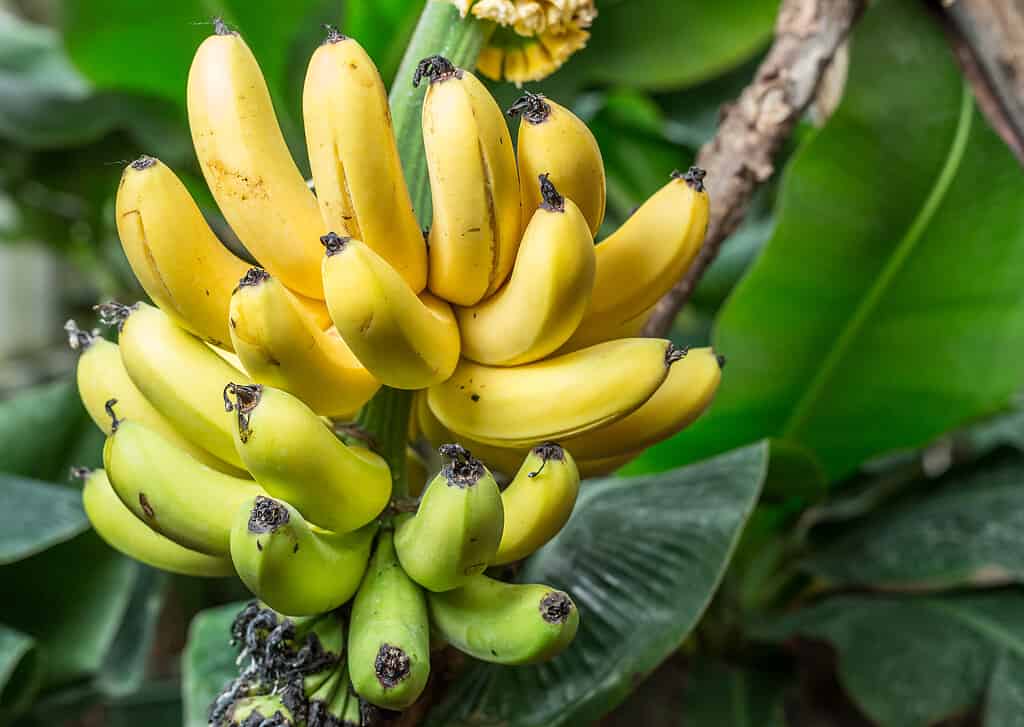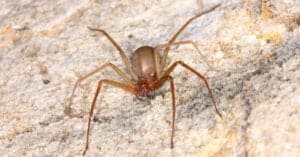
A ripe bunch of bananas on their palm tree.
©Valentyn Volkov/Shutterstock.com
Humans worldwide eat over one hundred billion bananas every year. The Cavendish banana, which is the most common type of banana, makes up most of that amount. However, it may not be long before that changes. Several days ago, The New York Post first announced that bananas could go extinct soon. A specific type of fungal disease poses a threat to the Cavendish bananas. There have been disagreements on how to handle this particular manner.
What Makes The Cavendish Bananas Globally Popular?
Business Insider stated that there are over one thousand different types of bananas, but forty-seven percent of humans eat the Cavendish banana (Musa acuminata.) There are three main reasons as to why the Cavendish dominates the banana market. The first is that it has a very long shelf life compared to many other banana types; the second reason is that the Cavendish is resistant to most banana-killing diseases; and the final reason is that farmers can grow the Cavendish on many different land types, unlike other banana types.
What’s The Threat To The Cavendish Banana?
The posing threat to the Cavendish is the Tropical Race 4, commonly known as the Panama Disease. TR4 is creating the growing possibility of bananas going extinct. It’s a fungus infection that originates in the banana tree’s roots and spreads to disable the tree’s ability to absorb water and hinder the photosynthesis process. If a tree doesn’t have the ability to go through photosynthesis, the tree dies.
According to the U.S. Department of Agriculture, the TR4 disease can also establish itself in the soils where the trees reside and survive for decades without a host. It could be spread over long distances by moving through infested soil grounds, contaminated plant equipment, and other infected plants.
This isn’t the first time this fruit has dealt with possible extinction. Another banana species, the Gros Michel, was a popular banana species in the first half of the 1900s. A predecessor to the TR4, the TR1, began infecting bananas around 1876. It eventually decimated many Gros Michel farms during the 1950s. Shortly after that, the Cavendish banans became growingly popular because it was immune to the TR1 pathogen.
The TR4 variant was discovered in 1989 in Taiwan. By 2015, it spread to the two largest banana-producing countries China and India. Fortunately, the disease moves slowly so scientists have approximately a decade to figure out how to counteract the TR4.
What Are Famers and Scientists Are Doing About This?
Several plant pathologists don’t think that the Cavendish will meet the same fate as the Gros Michel banana type. One of the possible solutions to combat the TR4 pathogen is for scientists to provide genetically modified versions of the banana that are resistant to TR4. How could that be done? Fruit grafting. Fruit grafting is the process of transplanting tissues between different types of plants to give them different types of characteristics such as disease immunity in this case.
Taiwan scientists are planning to do a natural selection where they expose the Cavendish banana seeds to the TR4 pathogen, so the seeds can develop some immunity to the pathogen. The best seedling groups that survive go on to continue in further experimentation to help the Cavendish evolve into a highly resistant banana species to TR4.
Dan Koeppel, the author of the book “Banana: The Fate of The Fruit That Changed The World“, argues that the proposed solutions are only temporary solutions. A problem Koeppel sees in this is the mass production of the solution and finding a great number of different banana types to produce genetic diversity so it could be immune to the disease.
Koeppel suggests that the solution would be to sell more types of bananas because the more genetically diverse they are, the better they’ll be able to be susceptible to disease. Koeppel told Business Insider “Apples are a huge example of this. Today, if I go to any supermarket in the United States, I will find between five and thirty apple varieties. Apple growers are going nuts trying to introduce new varieties naturally as well as through hybridization, and genetic modification. [It] reduces the risk of disease, offers more variety to customers, and as a result, apple growers are still making a lot more money because of this.”
To answer the question “Are bananas going extinct?” Not yet.
Thank you for reading! Have some feedback for us? Contact the AZ Animals editorial team.








